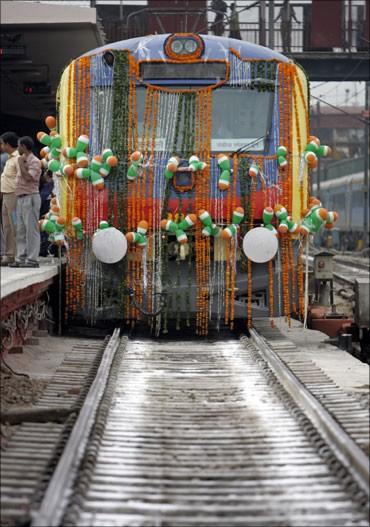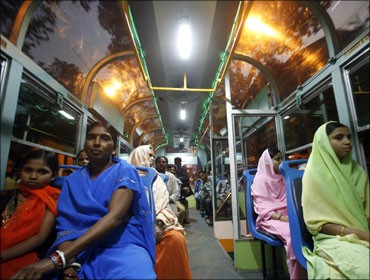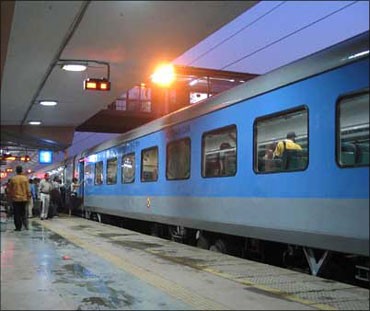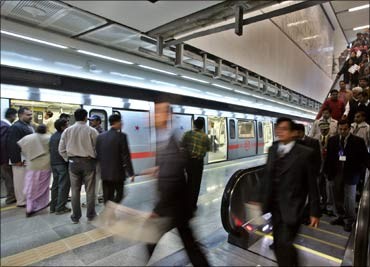 | « Back to article | Print this article |
Will a makeover really help the Indian Railways?
Indian Railways, the 150-year-old lifeline of India's transport sector, has been facing growing criticism lately owing to its deteriorating finances.
With surplus funds projected to fall at an all-time low of Rs 1,300 crore (Rs 13 billion) in the current financial year and the operating ratio, a key efficiency indicator, at an all-time high of 92 per cent, the railways requires a massive makeover in asset utilisation and to open itself to the private sector, said R Sivadasan, former financial commissioner, Indian Railways.Will a makeover really help the Indian Railways?
Based on your assessment of fiscal indicators like operating ratio (OR), how do you view the current financial situation of the Indian Railways?
If the railways are unable to improve its OR to 80 per cent or even better, it will fail to generate adequate internal resources to support Plan expenditure during the 12th Plan and become a burden on the government by seeking heavy budgetary support.
Also, it will be forced to lean on huge market borrowings. Both government budgetary support and market borrowings carry an interest burden.
Such an image will dampen the enthusiasm of private participants in the railways' future projects offered on the public-private partnership (PPP) route. And the problem does not end there. The next Pay Commission awards will be due in just four years from now in 2015-16.
Unless the railways are able to massively ramp up its commercial performance and earn better surpluses, it cannot rebuild its fund balances. That means the railways will have to struggle to not only generate funds to support Plan expenditure, but even for meeting the next Pay Commission's liabilities.
Click NEXT to read more...
Will a makeover really help the Indian Railways?
What do you make of the new rail minister's statement that an increase in passenger fares would be avoided and revenue enhancement will be done through non-traditional sources of income like utilising the railways' land bank for commercial exploitation and cutting down power bills by setting up power plants?
All the railway ministers have insisted on not raising passenger fares because they believe that unless second class passenger comforts are improved and their value for money is enhanced, a fare hike will invite passengers' wrath and they may choose to migrate to buses.
Any government land-related transaction can create unimaginably complicated controversies, even if done through the most open and transparent auctions. Therefore, plans about big-ticket land leasing, licensing and development works may not easily provide much boost to the railways' non-ticket income.
Revenues may be slow to trickle in. It is better to seek help from state land and infrastructure development corporations for commercial development-related PPPs. The railways should also have flexibility in the form of rules so that its decisions on land utilisation for commercial purposes would not be questioned. Otherwise, bureaucrats will hesitate to take decisions.
The current rules are not conducive to taking decisions on sensitive matters related to land use like upfront revenues or recurring revenue shares and so on.
Click NEXT to read more...
Will a makeover really help the Indian Railways?
Also, it is difficult to cut down on power bills by constructing, say, a captive power plant. The cost of generating power today is not likely to be cheaper than what the railways already pays as fuel bills.
The cost of setting up a plant is Rs 6 crore per Mw at present. This would also require carbon-emitting coal. The fly-ash generated would have to be disposed of. And the rail ministry as government in business, would be expected to meet all these obligations.
Then surplus power will have to be transferred to the National Grid on barter, and it might not fetch high prices. The ministry must see that such proposals are doable before announcing plans. You are setting up a plant at a time when the environmental laws are being tightened.
And if the government violates rules, it will be highlighted very strongly. The concerns raised are not Cassandra's predictions. They are only a hint for policymakers to think twice before deciding that there shall be no fare revisions now or in the future.
Click NEXT to read more...
Will a makeover really help the Indian Railways?
How justified are the current high levels of OR based on the classical argument that the railways has a social obligation to fulfill in addition to commercial business?
OR reveals everything about the financial health and operating efficiency of a rail system. Ideally, a well-managed large freight railway system (like the US railroads) will boast of a sustainable OR between 75 and 85 per cent.
A well-operated pure passenger system can hope to achieve 95 per cent. In India and China, the situation is very different. Both have mixed traffic - passenger and freight streams.
Therefore, OR may be in the range of 90 per cent. At the moment, the railways are managing an OR of between 90 and 95 per cent. Being a mixed traffic system does not justify such high ORs.
Being dominated by freight traffic and having the advantage of a massive population using the railway system, the railways' OR can be better at even less than 80 per cent if managed by a very efficient Railway Board that adheres to teamwork, irrespective of whoever is the railways minister.
Click NEXT to read more...
Will a makeover really help the Indian Railways?
How do we achieve an OR of less than 90 per cent?
If the gross traffic earnings are Rs 1,00,000 crore, the total working expenses of the railways should be limited to Rs 90,000 crore or less if it has to target an OR of 90 per cent.
But the golden rule is that between six and eight per cent of the total earnings should be contributed to Depreciation Reserve Fund (DRF). The railways should not drastically under-contribute cash to DRF to exaggerate an improvement in OR.
A 90 per cent OR will provide only very little cash surplus after paying dividend and the Indian Railways Finance Corporation (IRFC)'s capital component of lease charges.
Click NEXT to read more...
Will a makeover really help the Indian Railways?
What should be the way out of the current financial mess?
Effective asset utilisation, raising engineering, operating and commercial performance efficiencies, a bit of balanced fare re-adjustments, a massive drive to improve the passenger train load factor, competitive marketing and opening up freight and passenger sector for private train operators would do the trick for garnering increased revenues. There are a number of other ways to increase revenues.
With a rapid Gross Domestic Product (GDP) growth of eight per cent and above, there is an increased demand for social goods and industrial raw materials, coal and other bulk goods. Thus, there is no dearth of goods to be carried.
What is required is a Railway Board with the correct perspective and top-down approach to guide the Indian Railways in developing an excellent marketing aptitude and top-notch operating performance.







